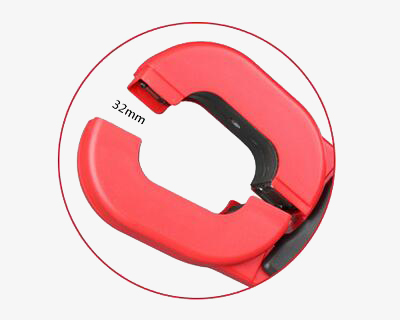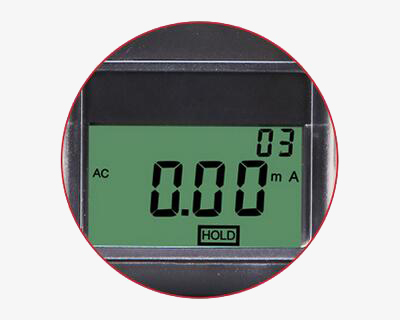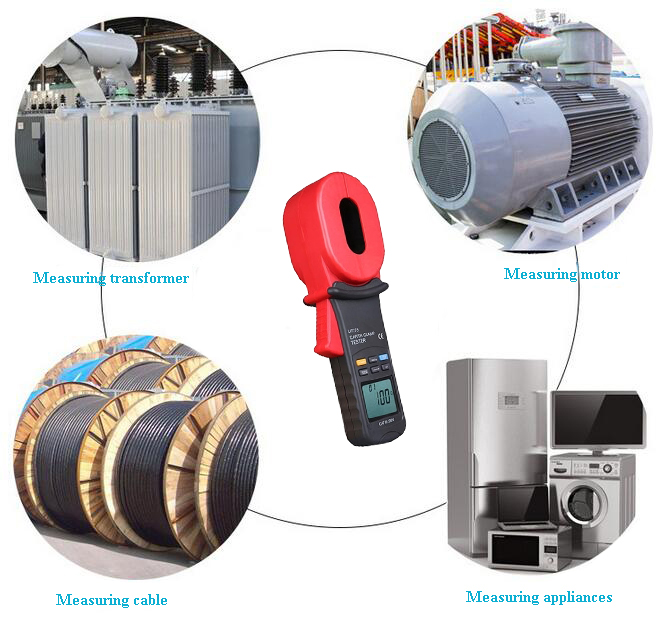sisco clamp-on earth ground tester can measure the ground resistance from 0.01Ω to 1000Ω. With the clamp on the loop, the meter can get the resistance value safely and quickly without disconnecting circuit ground lines or in needless of auxiliary electrodes. This clamp-on ground resistance tester is durable and accurate, suitable for grounding system measurement of electric power system, telecommunication, meteorology, oil field, building and other fields.

Clamp-on earth resistance tester with 32mm jaw opening
The clamp-on ground insulation tester has a jaw opening size of 32mm, and its sturdy design has become an electrical instrument with superior performance.

Clamp-on earth resistance tester with LCD backlight display
The measurement data is displayed with functional symbols, the readings are clear at a glance and high-definition, and the data can be displayed in a backlight.
Applications
The clamp-on earth ground resistance tester is suitable for measuring the insulation resistance of various electrical equipment and insulating materials such as transformers, motors, cables, switches, electrical appliances, and for maintenance, testing and verification of various electrical equipment.

| Model | SISCO-GRT-UT273 | SISCO-GRT-UT275 | |
| Earth Ground Resistance (Ω) | 0.01Ω~0.099Ω | ±(1%+0.01) | ±(1%+0.01) |
| 0.1Ω~0.99Ω | ±(1%+0.01) | ±(1%+0.01) | |
| 1.0Ω~49.9Ω | ±(1.5%+0.1) | ±(1.5%+0.1) | |
| 50Ω~99.5Ω | ±(2%+0.5) | ±(2%+0.5) | |
| 100Ω~199Ω | ±(3%+1) | ±(3%+1) | |
| 200Ω~395Ω | ±(10%+5) | ±(10%+5) | |
| 400Ω~590Ω | ±(20%+10) | ±(20%+10) | |
| 600~1000Ω | ±(25%+20) | ±(25%+20) | |
| Leakage Current (A) | 0.00mA~299mA | — | ±(2.5%+2mA) |
| 0.30A~2.99A | — | ±(2.5%+100mA) | |
| 3A~30A | — | ±(2.5%+100mA) | |
| Features | Display | 9999 counts | 9999 counts |
| Auto range | √ | √ | |
| Jaw opening | 28mm | 28mm | |
| Auto power off | √ | √ | |
| Low battery indication | √ | √ | |
| Data hold | √ | √ | |
| Data storage | 30 sets | 30 sets | |
| Data recall | √ | √ | |
| LCD backlight | √ | √ | |
| Auto calibration | √ | √ | |
| General | Power supply | 1.5V battery (LR6) x 4 | |
| Display size | 47mm x 28.5mm | ||
| Operating temperature | 0℃ ~ 40℃ | ||
| Operating relative humidity | 10%~90%RH non-condensing | ||
| Operating altitude | ≤2000m | ||
| Product weight | 1.5kg | ||
| Product size | 293mm x 90mm x 66mm | ||
| Standard accessories * | Batteries, test ring, carrying box | ||
Note: * Batteries are Not Included for air shippment.
Q1: What is a insulation tester?
A1: Insulation tester, also known as megohmmeter or meggers, are widely used to measure cables for generators, motors, power transformers, wiring, appliances and other electrical installations such as control, signal, communication and power ) insulation resistance. They are often used in routine maintenance procedures to indicate changes in the insulation resistance of a motor over months or years. Large changes in insulation resistance may indicate potential failures. Therefore, regular calibration of the megohmmeter is required to ensure that the meter itself has not changed over time.
Q2: What is insulation resistance?
A2: Insulation resistance is the DC resistance of the insulation under the specified conditions, that is, the DC voltage is applied to the dielectric, after a certain period of polarization, the resistance corresponding to the leakage current flowing through the dielectric is called insulation resistance. It is the most basic insulation index of electrical equipment and electrical circuit.
Q3: How to measure insulation resistance?
A3: 1. Connect all the lines according to the method measured by the insulation resistance tester. The connection between the measuring lead and the pipe is more suitable for the use of magnetic joints or clips, and the connection point must be free of rust.
2. The measuring instrument should be a 500V/500MΩ (the error here cannot be greater than 10%) insulation tester. Turn the handle of the megohmmeter to reach the specified speed for 10 seconds. The resistance value indicated by the megohmmeter stably is the insulation resistance value of the insulating joint (flange), which is required to be greater than 10 megohms.
Tips: What is a clamp-on earth resistance tester?
The clamp-on earth resistance tester can measure the connection resistance of any looped system without using an auxiliary ground rod or interrupting the grounding of the equipment under test. As long as the ground wire or ground rod is clamped with the clamp head, the ground resistance can be measured safely and quickly. It can also be applied to multiple parallel grounding systems. The clamp-on ground resistance tester can measure the leakage current of 1MA, and the neutral line current can reach 20A. This function is especially important when the ground network to be tested contains large noise and harmonics.
Thank you for buying industrial test and measurement equipment on SISCO.com, all products sold by SISCO and the partner cover a 12 months warranty, effective from the date of receiving the products.
What is covered?
SISCO is responsible for providing free spare parts, and free technical support to assist the customer to repair the defective products until the problem is solved.
What is not covered?
- Product purchased from anyone other than a SISCO store or a SISCO authorized reseller.
- Expendable parts.
- Routine cleaning or normal cosmetic and mechanical wear.
- Damage from misuse, abuse or neglect.
- Damage from use of parts other than SISCO approved.
- Damage from use outside the product’s usage or storage parameters.
- Damage from use of parts not sold by SISCO.
- Damage from modification or incorporation into other products.
- Damage from repair or replacement of warranted parts by a service provider other than a SISCO authorized service provider.
- Damage caused by the application environment not meeting the product usage requirements and the failure to perform preventive maintenance.

